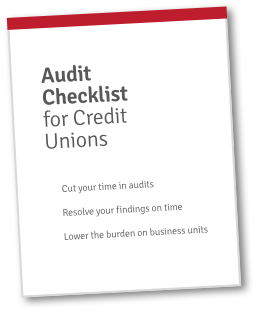In a recent survey, more than 80% of respondents reported that avoiding mistakes is their primary concern during the audit process. Other respondents expressed concern with maintaining clear channels for communication. Both speak to the stress inherent in the audit process, as well as what type of risks that process poses to your credit union.
Whether it’s your first internal audit or your hundredth; whether you’re using state-of-the-art tools and software to manage your examination or you’re holding things together with spreadsheets and sticky notes, you’re in for a wild ride*. Brace yourself, because failing to properly demonstrate compliance has consequences.
There are Three Components of Risk Assessments:
1. Risk Assessment for Credit Unions
Taking on risks is sort of like gambling for your credit union. Each risk a credit union takes on can increase its value and profitability, but it also exposes credit unions to the potential for losses; boards hate losses and surprises.NCUA rules and regulations are designed to maintain the health and stability of credit unions. As such, they check in periodically to ensure that credit unions are properly assessing and mitigating risk.
One of the things that your auditor is going to look for are the risks posed to your credit union. These risk areas include, but aren’t limited to:
- Credit risk
- Interest rate risk
- Liquidity risk
- Transaction risk
- Strategic risk
- Reputation risk
- Compliance risk
- IT risk
Any credit union risk assessment would be well-served to address each of these factors. Not only would concentrating on only a few areas be inadequate for examination purposes, but many risks are interrelated.
For example, when assessing compliance risk, it’s important for credit unions to remember that failure to maintain compliance may result in regulatory action and decreased member confidence—suddenly, compliance risk affects reputation risk.
2. To Mitigate, or to Litigate?
One helpful step would be to run an internal audit report of your risk management process. Knowing that your credit union can demonstrate adequate risk assessment, complete with full documentation compliance, can save a lot of heartbreak down the road.During an internal audit, you can expect to involve many experts in key areas of your credit union. Each expert in each area will be responsible for a share of the audit’s success. This is where clear lines of communication shine.
From the first letter, to the distribution of that request, to the collection of documents, all the way to review and delivery, you team will have its hands full. They’ll be expected to find what they need, then deliver answers and documentation for review, all while on a relatively short timeline.
Unfortunately, failure to demonstrate adequate risk assessment and mitigation may result in litigation (or other fates with varying degrees of severity).
3. The Right Tools for the Job
Credit unions have a few ways to approach the audit process. Smaller credit unions or those with infrequent audits often find satisfactory tools in spreadsheets, email, and sticky notes. Credit unions that need a higher degree of efficiency often employ auditing software to assist them.No matter which tools you use, your credit union will need to show a healthy level of risk when demonstrating compliance. Failure to do so could mean another major investment of time and money for follow-up questions, administrative action, or extended mediation.
A robust platform that keeps all involved people, all required documents, and all due dates in line can work wonders. These are the concerns of the 80% who want more than anything to avoid mistakes during the internal audit process. If you’re worried that anything might fall through the cracks, well, that’s a risk you can mitigate just by using the best tools for the job.

FREE: Audit Checklist for Credit Unions
4 key principles and 9 questions to jumpstart your audit planning. From leading credit unions.Surviving Your Internal Audit Report
Each credit union has its own concerns regarding compliance, communication, and risk management. When it comes to mitigating risk during an audit, just remember that you have a few things to keep track of: first, you must analyze multiple key areas of risk. Second, you have to collaborate with your experts. Third, you must compile and deliver.No audit is easy, and a lot can go wrong if you don’t take great care to communicate effectively and avoid mistakes. Whether you prefer spreadsheets and sticky notes or sophisticated audit tools, we wish you good luck (and better organization).
---
*We use the term “wild ride” loosely here
If you would like to learn more about internal audits and how Redboard can help you ace your next audit, then follow these links:
Are You Ready for Your Internal Audit?
Why Use a Tool for Your Audit Process?






